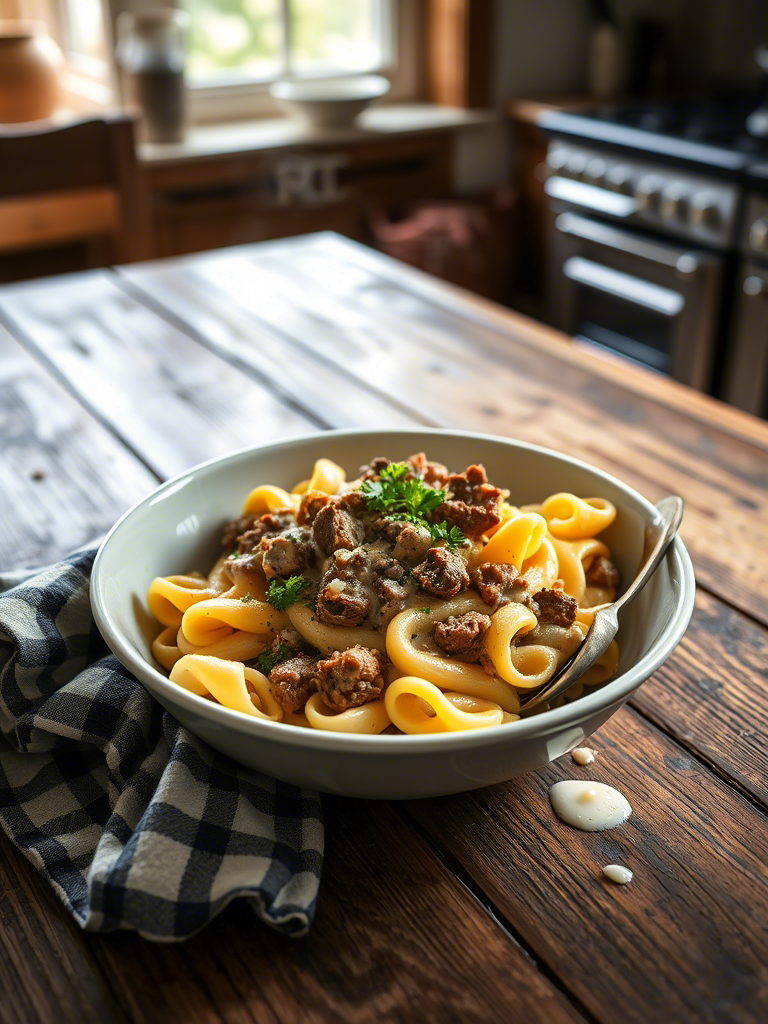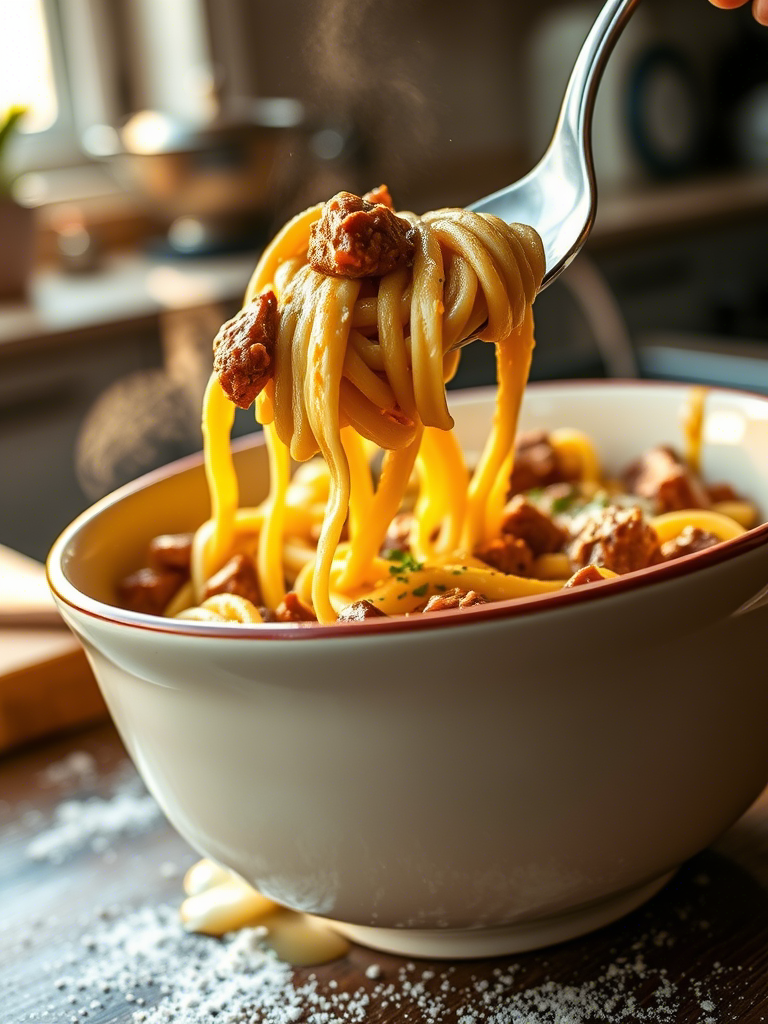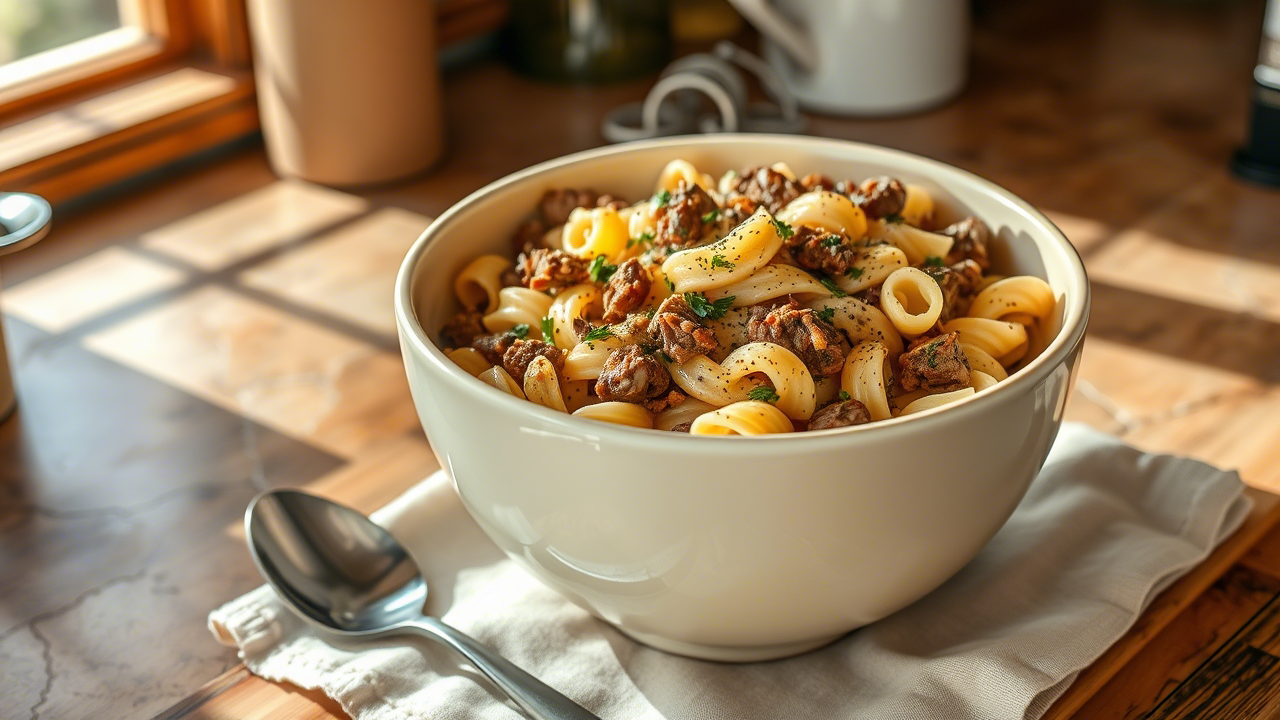There’s something unreasonably satisfying about a meal that tastes like it took three hours but actually dirties just one pan. Professionals know—clean-up eats time. And in a fast-paced kitchen, time is brutal currency. That’s why One-Pot Creamy Beef and Garlic Butter Pasta isn’t just a midweek dinner. It’s a lesson in smart layering, flavor stacking, and minimal fuss with maximum yield.
This isn’t your average pantry dump. It’s finesse in a pot. The garlic sings, the beef grounds it all down, and the pasta becomes more than filler—it becomes sponge, vessel, and hero.
This article dives deep. We’ll break down ingredient science, flavor architecture, and method mechanics. Not for TikTok cooks—this is for those who burn their sleeves near the stove, who can smell scorched garlic from two rooms over.
Let’s get into it.
The Flavor Architecture of a One-Pot Wonder
A one-pot pasta lives or dies on its build order. That might sound like a strategy game reference—and it kinda is.
Professional kitchens build in stages. First, aromatics. Then, protein. Then fat. Then liquid. Each move should answer one question: How does this deepen the flavor?
In this dish, it starts with garlic. Real garlic. Not powdered. Not pre-minced in oil that’s been oxidizing since April. Six cloves minimum. Smash, don’t slice. You want that brutal garlic perfume to wake up the oil and let it bleed into the beef fat later.
Then the beef. Not ground too fine. If it looks like pink sand, toss it. Go for coarser ground chuck, at least 80/20. That fat is not your enemy—it’s the reason this dish works.
Render it in the pan with the garlic. No stirring. Let it sit and develop those crispy brown bits at the bottom—the fond. That’s gold. That’s flavor residue you can’t buy.
Deglaze that with white wine if you’re feeling fancy or just a good beef stock splash. You’re not just adding liquid—you’re pulling flavor back into the mix.
The Cream Factor: Why It’s Not Just About Dairy
Creamy isn’t a texture. It’s a vibe. It’s a mouthfeel, yes, but also a taste sensation driven by fat content, emulsification, and reduction.
The fat here comes from three places: beef renderings, butter (not optional), and heavy cream or crème fraîche if you’re brave. Some use half-and-half. Don’t. It’ll break under heat and split like a teenager’s first band.
Once the beef and garlic are cozy, you stir in your uncooked pasta. Straight in. No boiling. No draining. The starch from that pasta releases right into the sauce. That’s your thickener. That’s your natural binder. No flour needed. Ever.
Now, add stock and cream together—1:1 ratio is safe. You’ll need just enough to cover the dry pasta. Bring it to a gentle simmer and don’t walk away. Stir like it owes you money. Keep the heat low-medium and let it work its magic.
Garlic Butter: More Than a Trend
Garlic butter gets memed to death, but it’s foundational. Especially in high-fat, high-starch dishes like this one. You want richness with edge—garlic gives you that.
Here’s the kicker: the garlic butter isn’t just in the base. You’re hitting it twice. Once early, once at the end. The finish is critical. A final tablespoon of garlic butter at the end, stirred in off the heat, rounds everything out. It’s like sending a warm-down note to the whole dish. It settles the flavors and adds that slick, luxurious finish chefs fight over.
And yes, use unsalted butter. Because control is everything. Salted butter robs you of precision.

Pasta Choice Matters—A Lot More Than You Think
Don’t just grab penne because it’s there. This isn’t “whatever’s in the cupboard” night.
Choose pastas with bite and capacity. Rigatoni, campanelle, or even mafaldine. You want surface area and nooks. This sauce clings, and it deserves a pasta that understands the assignment.
Avoid thin, delicate noodles. Spaghetti? Meh. Angel hair? Disaster. They’ll overcook and turn the dish into a weird dairy stew. We’re not doing that.
Also—semolina-based dry pasta is key. Fresh pasta won’t hold up to this one-pot technique. It gets gummy. Trust the box.
Layering Seasonings Like a Pro
Salt once, early. Then salt again later. Think of seasoning in waves. You hit it while the beef cooks, then again in the sauce, then adjust at the end.
Don’t just rely on salt and pepper. A hit of chili flakes adds dimension. A whisper of nutmeg (yes, nutmeg) in the cream brings warmth. Just a pinch. It shouldn’t taste like nutmeg—it should taste like something’s more rounded.
You can also add umami notes. A splash of Worcestershire or even a teaspoon of soy sauce blends in under the radar and boosts everything.
Emerging Trends: Why One-Pot Creamy Dishes Are Back
One-pot meals have been around forever, but their comeback isn’t just nostalgia. It’s operational efficiency.
Professional caterers and even upscale restaurants are revisiting these types of dishes for event menus and large-scale prep. Why?
- Reduced dishwashing labor
- Controlled portion scaling
- High flavor-to-effort ratio
- Better yield management
In culinary schools, one-pot recipes are being used to teach layering and timing. If you mess up your sequence, the whole dish collapses. It’s a microcosm of larger kitchen skills.
Nutritional Insight: Is It “Too Rich”?
You’d think with beef, butter, and cream this is a dietary nightmare. But let’s talk portion control and balance.
A typical serving clocks in around 500–700 calories, depending on how heavy your hand is with the butter. But paired with greens—say, arugula tossed in lemon—this becomes a complete plate.
You can also adapt. Substitute half the cream with full-fat Greek yogurt for a tangy edge. Use leaner beef, though you’ll sacrifice depth. Add mushrooms to stretch the beef and inject earthiness.
Point is—you control the richness. The dish doesn’t dictate your choices.
Common Mistakes Even Pros Make
1. Too much liquid.
The pasta needs to absorb liquid, not swim in it. Measure stock and cream carefully. You can always add a splash later, but you can’t undo soup.
2. Overcooking pasta.
The biggest sin. Pasta continues cooking after the heat’s off. Stop when it’s al dente—even slightly under. It’ll carry over to perfection.
3. Not finishing with acid.
A squeeze of lemon or a dash of white wine vinegar at the end wakes up the whole pot. Without acid, the dish falls flat. Cream + beef needs a lift.
4. Skipping the second butter finish.
That final stir-in isn’t just for sheen. It balances salt, fattens mouthfeel, and gives the dish a professional polish.
A Word on Equipment: Don’t Use the Wrong Pot
This one’s critical. You need a heavy-bottomed pot. Stainless steel or enameled cast iron. Skip the thin non-stick stuff—it doesn’t conduct heat evenly and will burn the base.
Go for a pot that allows for full pasta submersion and some space to stir vigorously. You’ll be working the dish from raw to reduced all in the same space. Cramped pots = steam lock and uneven cooking.

Real-World Application: When This Dish Shines
This dish belongs in more than weeknight repertoires. It’s a smart solution for:
- Pop-up events with minimal equipment
- Private chef gigs with tight cleanup windows
- Restaurant staff meals (hearty, cheap, fast)
- Catering menus where speed and depth matter
It reheats shockingly well. A touch of milk or stock the next day revives it, unlike most cream-based dishes which split like a bad marriage under pressure.
Pro Variations: Taking It Further
You can riff, but with rules. A few pro-level spins:
1. Truffle and Mushroom Version
Replace half the beef with chopped cremini or shiitake. Add a touch of truffle oil at the end. Now you’ve got fine dining in one pot.
2. Gorgonzola Crumble Finish
Crumble blue cheese just before serving. It’ll melt into tiny pockets of funk. Wildly good with red wine.
3. Herb Bomb Variant
Stir in a handful of chopped parsley, tarragon, and chives at the end. The herbs cut through the cream and brighten the entire dish.
So, What Are We Left With?
One-Pot Creamy Beef and Garlic Butter Pasta isn’t just a cozy meal. It’s a study in how ingredients interact under pressure. A masterclass in controlling time, heat, and flavor—all in one vessel.
It forces you to think like a real cook. No hiding behind garnishes or plating tricks. Just beef, garlic, cream, and technique.
If you haven’t tried it, you’re missing a dish that teaches you more than you’d expect. And if you’ve done it before—do it again. But this time, do it slower. Smell every layer. Taste every stage.
Cooking’s not about racing to the plate. It’s about building something worth serving.
And this one—this one’s worth it.
FAQs
What type of beef is best for One-Pot Creamy Beef and Garlic Butter Pasta?
Use coarsely ground chuck with at least 80/20 fat for rich flavor and texture.
Can I use milk instead of heavy cream?
Milk will likely split—stick with heavy cream or crème fraîche for stability.
What kind of pasta works best in this recipe?
Use short, sturdy pasta like rigatoni or campanelle that holds sauce well.
Is it okay to use pre-minced garlic?
Fresh garlic is strongly preferred—pre-minced loses potency and flavor.
How can I make this dish less rich?
Cut the cream with Greek yogurt or use leaner beef and less butter.
Can this pasta be made ahead of time?
Yes, it reheats well—add a splash of stock or milk to revive the sauce.
Do I have to use butter twice?
Yes, finishing with garlic butter adds depth, richness, and a glossy finish.
How do I prevent the pasta from overcooking?
Cook until just shy of al dente—residual heat will finish it perfectly.
Can I make this dish gluten-free?
Yes, just use sturdy gluten-free pasta and monitor for doneness.
What’s a good garnish for this dish?
Fresh herbs, chili flakes, or a bit of grated Parmesan work beautifully.
Should I salt the pasta water?
No need—since the pasta cooks in the sauce, season the sauce itself.
Is one-pot pasta a professional technique?
Absolutely—it teaches timing, layering, and flavor development in one go.
Can I add vegetables to the dish?
Yes—mushrooms, spinach, or peas blend in seamlessly without overpowering.
What’s the biggest mistake people make with this recipe?
Adding too much liquid and ending up with a soupy mess.
How long does the whole recipe take?
From start to finish, around 30–35 minutes if done properly.
Ask ChatGPT

Mariana is a passionate home cook who creates delicious, easy-to-follow recipes for busy people. From energizing breakfasts to satisfying dinners and indulgent desserts, her dishes are designed to fuel both your body and hustle.
When she’s not in the kitchen, she’s exploring new flavors and dreaming up her next recipe to share with the Foodie Hustle community.

